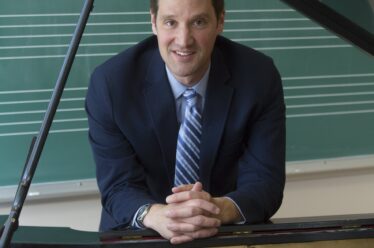David Thurmaier: Terezín 2018
I first encountered music by a Terezín composer around ten years ago when exploring the music of Janáček. I noticed that my CD of Janáček’s Second String Quartet also contained a quartet by Pavel Haas, whose name was also taken for the quartet playing on the same album. After listening, I found Haas’s Second String Quartet to be a quirky blend of Janáčekisms, allusions to popular music (particularly jazz with a percussionist playing in the last movement), and modernist music of the early twentieth century. This started a more serious investigation into the lives and music of the other composers who were imprisoned at Terezín.
Upon my arrival in Brno, then, I was excited to learn that Haas’s music manuscripts were housed at the Moravian Museum’s Department of the History of Music archives, literally a two-minute walk away from my office at Masaryk University (Haas is my personal favorite of the Terezín composers due to his strong Janáček and Brno connections and unique music). Accordingly, I made several trips to the archives to look at the manuscripts for Haas’s opera Šarlatan. I do not know where my research will take me on the opera, but I am pleased to know where its sources lie.
I’m especially pleased to share these observations in the Terezín Composers Institute Newsletter because I just returned from my time as a Fulbright Scholar at Masaryk University in Brno from January-July 2018, which put me in touch with the Institute’s Director Prof. Lubomír Spurný, with whom I share a fruitful and warm collegial relationship. Lubomír has great passion for this music and for making sure the stories of its creation are supported by serious scholarship (see Prof. Beckerman’s column in the last issue, for example).
In May 2018, I accompanied Lubomír and the graduate musicology students taking his seminar on Pavel Haas to Terezín for a tour and information about potential research possibilities. For most of the students, it was their first time visiting the camp, and it was often overwhelming for them emotionally and intellectually. We were guided by Petra Husáková, who used her talents as a former tour guide at Terezín to provide us with numerous stories and insights into the musical culture formed in the camp. After our tour, we walked into the town of Terezín and several MUNI students performed a concert inside the town hall that contained works by Terezin composers (I remember some songs by Gideon Klein, for example). It was a memorable experience for me, and one I am sure the students will not forget.
Even though I am now back in America, I am grateful for my experiences visiting Terezín and studying Haas’s music. I was pleased to read the following in the Institute’s mission statement:
Terezín will become the place for those who want to explore the works of Terezín composers and the Institute will be able to provide concise information to interested parties from around the world. The Institute shall thus preserve the cultural heritage which could otherwise be lost and forgotten.
And one goal for Fulbrighters is to:
Foster long-term collaboration and institutional linkages between scholars and U.S. academics.
In my role as a music theory professor at the University of Missouri–Kansas City, I will do what I can to include works by Terezín composers in my courses and to steer our graduate students interested in thesis projects to consider studying the lives and music of these composers. For it is through scholarly research and its dissemination, in addition to the fine endeavors begun by the Terezín Composers Institute like concerts and symposia, that this cultural heritage will endure for years to come.

